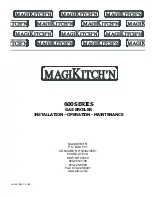
Part number 550-100-168/0516
43
b. The flue products will form a noticeable plume as they con-
dense in cold air. Avoid areas where the plume could obstruct
window views.
c. Prevailing winds could cause freezing of condensate and water/
ice buildup where flue products impinge on building surfaces
or plants.
d. Avoid possibility of accidental contact of flue products with
people or pets.
e. Do not locate the terminations where wind eddies could affect
performance or cause recirculation, such as inside building
corners, near adjacent buildings or surfaces, window wells,
stairwells, alcoves, courtyards or other recessed areas.
f. Do not terminate above any door or window. Condensate can
freeze, causing ice formations.
g. Locate or guard vent to prevent condensate damage to exterior
finishes.
h. Maintain clearances to vent termination as given below:
i. Vent must terminate:
s
At least 6 feet from adjacent walls.
s
No closer than 5 feet below roof overhang.
s
At least 3 feet above any forced air intake within 10 feet.
s
No closer than 12 inches below or horizontally from any
door or window or any other gravity air inlet.
j. Air inlet must terminate at least 12 inches above the roof or
snow line and at least 12 inches below the vent termination as
shown in Figure 38.
k. Do not terminate closer than 4 feet horizontally from any elec-
tric meter, gas meter, regulator, relief valve or other equipment.
5. Where the vent or air pipe penetrates the roof, the annular space
around the penetration must be permanently sealed using ap-
proved materials to prevent entry of combustion products into
the building.
6. Locate terminations so they are not likely to be damaged by foreign
objects, such as stones or balls, or subject to buildup of leaves or
sediment.
7. Do not connect any other appliance to the vent pipe or multiple
boilers to a common vent pipe.
Prepare roof penetrations
1. Air pipe penetration:
a. Cut a hole for the air pipe. Size the air pipe hole as close as
desired to the air pipe outside diameter.
2. Vent pipe penetration:
a. Cut a hole for the vent pipe. For either combustible or non-
combustible construction, size the vent pipe hole at least ½”
larger than the vent pipe diameter:
s
7” hole for 6” PP and PVC or 9” for 8” PP and PVC.
b. Insert a galvanized metal thimble in the vent pipe hole.
3. Space the air and vent holes to provide the minimum spacings
shown in Figure 38, page 43.
4. Follow all local codes for isolation of vent pipe when passing
through floors, ceilings and roofs.
5. Provide flashing and sealing boots sized for the vent pipe and air
pipe.
Termination and fittings
1. Prepare the vent termination coupling and the air termination
return bend (Figure 38, page 43) by inserting a bird screen in each.
&IGURE
Vertical termination — separate pipes
SlimFit
®
Series 3
COMMERCIAL
CONDENSING
GAS
-
FIRED
WATER
BOILER
—
Boiler Manual
DIRECT VENT — Vertical
(continued)
Содержание 550 MBH
Страница 126: ...Part number 550 100 168 0516 126 SlimFit Series 3 COMMERCIAL CONDENSING GAS FIRED WATER BOILER Boiler Manual Notes ...
Страница 127: ...Part number 550 100 168 0516 127 SlimFit Series 3 COMMERCIAL CONDENSING GAS FIRED WATER BOILER Boiler Manual Notes ...
Страница 128: ...GAS FIRED WATER BOILER Boiler Manual SlimFit Series 3 COMMERCIAL CONDENSING GAS FIRED WATER BOILER Boiler Manual ...
















































